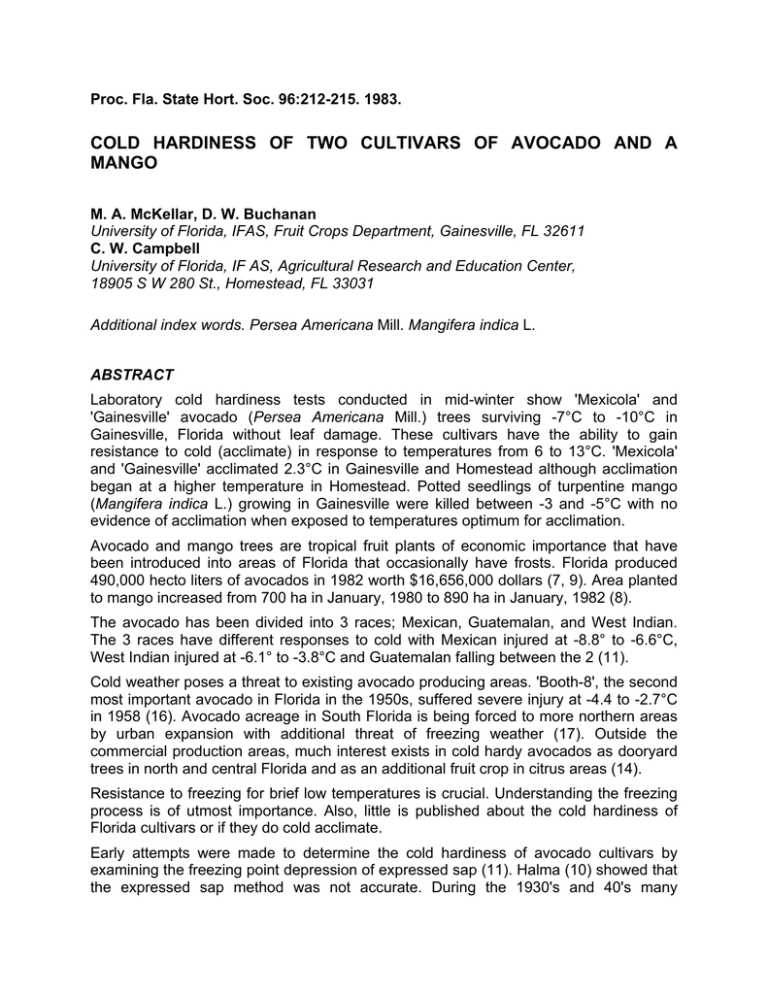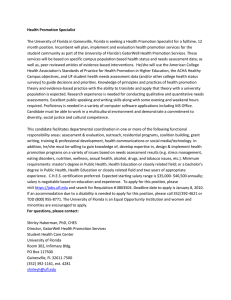COLD HARDINESS OF TWO CULTIVARS OF AVOCADO AND A MANGO
advertisement

Proc. Fla. State Hort. Soc. 96:212-215. 1983. COLD HARDINESS OF TWO CULTIVARS OF AVOCADO AND A MANGO M. A. McKellar, D. W. Buchanan University of Florida, IFAS, Fruit Crops Department, Gainesville, FL 32611 C. W. Campbell University of Florida, IF AS, Agricultural Research and Education Center, 18905 S W 280 St., Homestead, FL 33031 Additional index words. Persea Americana Mill. Mangifera indica L. ABSTRACT Laboratory cold hardiness tests conducted in mid-winter show 'Mexicola' and 'Gainesville' avocado (Persea Americana Mill.) trees surviving -7°C to -10°C in Gainesville, Florida without leaf damage. These cultivars have the ability to gain resistance to cold (acclimate) in response to temperatures from 6 to 13°C. 'Mexicola' and 'Gainesville' acclimated 2.3°C in Gainesville and Homestead although acclimation began at a higher temperature in Homestead. Potted seedlings of turpentine mango (Mangifera indica L.) growing in Gainesville were killed between -3 and -5°C with no evidence of acclimation when exposed to temperatures optimum for acclimation. Avocado and mango trees are tropical fruit plants of economic importance that have been introduced into areas of Florida that occasionally have frosts. Florida produced 490,000 hecto liters of avocados in 1982 worth $16,656,000 dollars (7, 9). Area planted to mango increased from 700 ha in January, 1980 to 890 ha in January, 1982 (8). The avocado has been divided into 3 races; Mexican, Guatemalan, and West Indian. The 3 races have different responses to cold with Mexican injured at -8.8° to -6.6°C, West Indian injured at -6.1° to -3.8°C and Guatemalan falling between the 2 (11). Cold weather poses a threat to existing avocado producing areas. 'Booth-8', the second most important avocado in Florida in the 1950s, suffered severe injury at -4.4 to -2.7°C in 1958 (16). Avocado acreage in South Florida is being forced to more northern areas by urban expansion with additional threat of freezing weather (17). Outside the commercial production areas, much interest exists in cold hardy avocados as dooryard trees in north and central Florida and as an additional fruit crop in citrus areas (14). Resistance to freezing for brief low temperatures is crucial. Understanding the freezing process is of utmost importance. Also, little is published about the cold hardiness of Florida cultivars or if they do cold acclimate. Early attempts were made to determine the cold hardiness of avocado cultivars by examining the freezing point depression of expressed sap (11). Halma (10) showed that the expressed sap method was not accurate. During the 1930's and 40's many observations were made after freezes although these reports are conflicting. Hodgson (12) observed that young Mexican race trees were killed to the ground by -9.4°C and that mature trees suffered substantial damage, but Camp (1) reported Mexican race trees survived -9.4°C with little damage. Hodgson (13) subsequently reported dieback of new growth on cold-damaged Mexican avocado trees. Camp and Wolf (2) reported avocado trees withstanding temperatures of -2.2 to -2.7°C, but the race was not specified. Mexican avocado trees, 'Mexicola' and 'Gainesville', have withstood temperatures of -6.6 to -9.4°C (14, 15). Water stress has been reported to induce cold hardiness in citrus (19, 21), and Cornus (4) among others. Increased cold tolerance is a result of decreased tissue hydration. Weiser (20) reported that short days initiate the first step of acclimation in many woody plants. Young (22) observed citrus trees cold acclimated more in response to low temperatures than to photoperiod. Increased cold hardiness in avocados growing in Gainesville cannot be explained by a difference in photoperiod since the photoperiod in Homestead and Gainesville are similar. Mango trees show high susceptibility to cold injury. Young trees are damaged by temperatures of -0.5°C. Variability among cultivars is apparent after a cold spell, but precise information on this subject is non-existent (3), nor is it known if mangos can acclimate to cold. Laboratory cold tests were conducted to determine if the killing point of avocado and mango leaves changed during the season in response to low temperature. Trees of 2 Mexican avocados, 'Gainesville' and 'Mexicola', were tested in Gainesville and Homestead and potted seedlings of turpentine mango were tested in Gainesville to evaluate the ability of avocado and mango trees to acquire cold tolerance during exposure to low temperatures. MATERIALS AND METHODS Leaves from mature trees of 2 'Mexicola' and 'Gainesville' avocados growing at the Agricultural Research and Experiment Center in Homestead were tested for cold hardiness about every 3 wk from October, 1982 until February, 1983. Mature trees of 'Mexicola' and 'Gainesville' are in the avocado collection at Gainesville. Leaves from 2 trees were tested on 9 dates from October until April. Excised mature terminal leaves were subjected to controlled freezing and injury was estimated immediately afterwards using a modification of the electrolyte leaching technique (5, 6). Leaves were washed in deionized water and placed leaf-tip down in 75 ml test tubes. One to 3 ml of deionized water was added to each test tube. Stoppered test tubes were submerged in a glycol refrigerated bath at -3.0°C once the bath temperature was reached, samples were nucleated with crystals of ice, and held overnight at -3.0°C to allow the tissues to equilibrate. Leaf temperature was monitored throughout the test with copper constantin thermocouples. Test tubes were removed hourly at successively lower 1.0°C temperature intervals. After freezing, test tubes were placed in an ice bath to gradually allow the tissue temperature to rise to 0.0°C. Leaves were then sliced into lateral 10 cm strips, placed in individual test tubes with 30 ml of deionized water and incubated for 24 hr. Solutions were then agitated. Electrical conductivity readings were taken on the solutions and the test tubes were then autoclaved for 15 min, and then incubated again for 24 hr. Conductivity readings were again taken on each sample. Leaves of seedling turpentine mango growing outdoors in pots in Gainesville, Florida were randomly selected and tested for cold hardiness in the same manner 4 times during the year. Plants were moved into greenhouses only when the temperature dropped below 0°C to allow plants to acclimate as much as possible. Xylem water potential (18) was measured on 'Gainesville' in Gainesville on January 25 and 26, 1983, and Homestead on February 6 and 7, 1983, at 2:00 PM and 7:00 AM the following morning. Ambient temperature data for Gainesville, Florida were collected by the University of Florida Department of Agronomy Farm Weather Station located within 3.2 km of the Gainesville avocado collection. Ambient temperature data for Homestead, Florida was collected by the University of Florida Agricultural Research and Education Center within 0.4 km of the Homestead avocado collection. RESULTS AND DISCUSSION Avocado freezing tests. 'Mexicola' avocado growing in Homestead was killed at -7°C on November 15, 1982 while on January 17, 1983 it was killed at -8.2°C (Fig. 1). 'Mexicola' growing in Gainesville was killed at -8.8°C on November 21, 1982 while on January 30, 1983, it was killed at -10.5°C. 'Gainesville' avocado growing in Homestead was killed at -5.8°C on November 15, 1982 and at -7.8°C on January 17, 1983. The same cultivar growing in Gainesville was killed at -8.2°C on November 7, 1982 but was not killed until -10.0°C on January 30, 1983 (Fig. 2). 'Mexicola' and 'Gainesville' acclimated to cold in Homestead and in Gainesville. Leaves of 'Mexicola' and 'Gainesville' were exposed to subfreezing temperatures on January 30, 1983. Leaves were left intact for 3 days and examined visually to determine killing point. Killing point as indicated by change from live leaves to dead leaves was identical to killing point indicated by electrolyte leakage measurements on 'Mexicola and 'Gainesville'. 'Mexicola' growing in Gainesville acquired 2.3°C more cold hardiness than it did growing in Homestead when at maximum cold hardiness. Homestead is located 480 km south of Gainesville. Average low temperature for the week preceding the cold hardiness test was 10.4°C for Homestead and 4.6°C for Gainesville. 'Gainesville' avocado growing in Gainesville had 2.2°C more cold hardiness than the same cultivar growing in Homestead, probably also resulting from lower temperatures in Gainesville. Two comparisons between Homestead and Gainesville were made for a date when the 2 locations had similar temperatures for 10 days preceding tests. This comparison suggests that cold hardiness is greater in Gainesville. Although the 2 test dates compared had the same average temperatures for the 10 days preceding testing, the avocado trees growing in Gainesville were exposed to lower temperatures for a longer period of time than the trees growing in Homestead. This longer cold period is a possible cause for the increased cold hardiness of the avocado trees growing in Gainesville. This trend would be expected in plants that have capacity to acclimate to cold. If they did not acclimate, avocado trees in Gainesville and Homestead should be killed at the same temperatures (Fig. 3). The possibility exists that 'Mexicola' and 'Gainesville' growing in Gainesville developed more cold hardiness than reported. All tests but one were stopped at -9.0°C at which point leaves of 'Mexicola' and 'Gainesville' often were not killed. Each cultivar acclimated to about the same extent, even though temperatures were higher to start with in Homestead. New flush leaves of 'Gainesville' and 'Mexicola' were killed at -3.0°C on May 16, 1983 while more mature leaves of 'Gainesville' were killed at —7.0 and 'Mexicola' were killed at -7.4°C (Fig. 4). Tender new leaves of both cultivars growing in Gainesville were injured at temperatures above -3.0°C. Mature growth which has been exposed to some cold weather was killed at -7.0 to -7.4°C. Avocado xylem water potential. Xylem water potential of 'Gainesville' avocado growing in Homestead approached 0 bars at 2:00 PM on February 6, 1983 and 7:00 AM on February 7, 1983. Xylem water potential of 'Gainesville' avocado growing in Gainesville was -6.2 bars at 2:00 PM on January 25, 1983 and -2.1 at 7:00 AM on January 26, 1983. Increased cold tolerance may result in avocado trees grown in Gainesville that have a lower xylem water potential. Temperature. Average minimum temperature for each of the 10 days preceding laboratory cold hardiness runs was calculated for Homestead and Gainesville (Table 1). The lowest average night temperatures for Gainesville were 5.1°C lower (2.9°C) then the lowest average night temperatures in Homestead (8.3°C). Average night lows dropped below 10°C preceding only 1 test date in Homestead but were below 10°C for 4 months in Gainesville. Temperatures in Gainesville are lower than in Homestead, Florida earlier in the fall; hence acclimation to cold probably starts earlier. Mango freezing tests. Seedling turpentine mango in pots growing in Gainesville were killed at less than -3°C on February 9 and August 10, 1983, -4.5°C on April 29, 1983, and -5.0°C on May 16, 1983 (Fig. 5). The response of seedling mango trees is more difficult to explain. Freezing at temperatures above -3.0°C occurred on 2 occasions as reported previously (3); however, in 2 other tests the leaves were not damaged above -4.5°C. Results do not conclusively indicate whether turpentine mangos acclimate to cold but suggest that they do not. LITERATURE CITED 1. Camp, A. F. 1930. Variety, propagation and planting tests of pear, avocado, Japanese persimmon, fig, and other fruits. Florida Agr. Expt. Sta. Annu. Rpt. 81. 2. Camp, A. F. and H. S. Wolfe. 1934. Variety tests of minor fruits and ornamentals. Florida Agr. Expt. Sta. Annu. Rpt. 65-66. 3. Carmichael, W. W. 1958. Observations of cold damage to mangos in Dade County and the Lower West Coast. Proc. Fla. State Hort. Soc. 71: 333-335. 4. Chen, P. M., P. H. Li, and M. J. Burke. 1977. Induction of frost hardiness in stem cortial tissues of Cornus stolonifer. Michx. by water stress. Plant Physiol. 59: 236239. 5. Dexter, S. T., W. E. Tottingham, and L. F. Graber. 1932. Investigations of the hardiness of plants by measurements of electrical conductivity. Plant Physiol. 7: 6379. 6. Fling, H. L., B. R. Boyce, and D. J. Beattie. 1967. Index of injury— a useful expression of freezing injury to plant tissues as determined by the electrolytic method. Can. J. Plant Sci. 17: 229-230. 7. Florida Crop and Livestock Reporting Service. Cash receipts from farming. Oct. 14, 1982. 8. Florida Crop and Livestock Reporting Service. Tropical fruit. Oct. 22, 1982. 9. Florida Crop and Livestock Reporting Service. Avocados. April 20, 1983. 10.Halma, F. F. 1942. Leaf sap concentration and cold resistance in the avocado. Calif. Avocado Soc. Yearbook 48-53. 11.Harris, J. A. and W. Popenoe. 1916. Freezing-point lowering of the leaf sap of the horticultural types of Persea americana. J. Agr. Res. 7: 261-268. 12.Hodgson, R. W. 1933. Resistance to low winter temperature of subtropical fruit plants. Proc. Amer. Soc. Hort. Sci. 30: 349-354. 13.Hodgson, R. W. 1934. Further observations on frost injury to subtropical fruit plants. Proc. Amer. Soc. Hort. Sci. 32: 227-229. 14.Krezdorn, A. H. 1970. Evaluation of cold hardy avocados in Florida. Proc. Fla. State Hort. Soc. 83: 382-386. 15.Krezdorn, A. H. 1973. Influence of rootstock on cold hardiness of avocados. Proc. Fla. State Hort. Soc. 86: 346-348. 16.Krome, W. K. 1958. Observations on cold damage to avocado in Dade County. Proc. Fla. State Hort. Soc. 71: 338-341. 17.Manis, W. E. and R. J. Knight, Jr. 1967. Avocado germplasm evaluation: technique used in screening for cold tolerance. Proc. Fla. State Hort. Soc. 80: 387-391. 18.Scholander, P. F., H. T. Hammel, E. D. Bradstreet, and E. A. Hemmingsen. 1965. Sap pressure in vascular plants. Science 148: 339-345. 19.Wilcox, D. A., F. S. Davies, and D. W. Buchanan. 1983. Root temperatures, water relations, and cold hardiness in two citrus rootstocks. J. Amer. Soc. Hort. Sci. 108: 318-321. 20.Weiser, C. J. 1970. Cold resistance and injury in woody plants. Science 169: 12521278. 21.Yelenosky, G. 1979. Water-stress-induced cold hardening of young citrus trees. J. Amer. Soc. Hort. Sci. 104: 270-273. 22.Young, R. H. 1961. Influence of day length, light intensity, and temperature on growth, dormancy, and cold-hardiness of Red Blush grapefruit trees. Proc. Amer. Soc. Hort. Sci. 78: 174-179.



